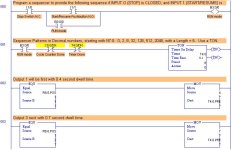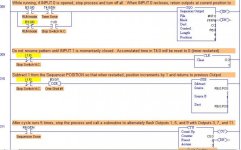Gobbling Ganster
Member
I have most of this program finished but wasn't sure on how to do the switches for this program. I worked around it and finished most of it. I will paste the parts for the program and an attachment of what I have.
*Program a sequencer to provide the following sequence if INPUT O (STOP) is CLOSED, and INPUT 1 (START/RESUME) is MOMENTARILY CLOSED.
*Output 1 will be first with .4s dwell time
Output 3 next with .7s dwell time
Output 5 next with .5s dwell time
Output 7 next with .8s dwell time
Output 9 next with .6s dwell time
Output 11 next with .9s dwell time
I have this part done besides the dwell time. Wasn't sure on how to approach this.
*While running, if INPUT 0 is opened, stop the process and turn off all of the outputs. When INPUT 0 is closed, return the outputs in the current state on, but do not resume the pattern until INPUT 1 is momentarily closed. When pattern is resumed, the time in the accumalted value time in the current position should be rest. (use a TON).
This is the one part I did not do because I the switches were giving me hard time.
*After the cycle runs 5 times, stop the process and call a subroutine to alternately flash outputs 1, 5, and 9 and 3, 7, 11 every 1 second. (Considered O/0 an even number). If INPUT 0 is opened, turn off the outputs while it is off, but resume flashing when INPUT 0 is closed.
I have most of this part finished but again the switches I did not know how to approach. So I worked around it.
*Use a second subroutine to reset the cycle counter if Input 0 is opened and INPUT 1 is closed 4 time.
I have this part mostly finished but again the switches part I was not sure about.
Some help would be greatly appreciated!
*Program a sequencer to provide the following sequence if INPUT O (STOP) is CLOSED, and INPUT 1 (START/RESUME) is MOMENTARILY CLOSED.
*Output 1 will be first with .4s dwell time
Output 3 next with .7s dwell time
Output 5 next with .5s dwell time
Output 7 next with .8s dwell time
Output 9 next with .6s dwell time
Output 11 next with .9s dwell time
I have this part done besides the dwell time. Wasn't sure on how to approach this.
*While running, if INPUT 0 is opened, stop the process and turn off all of the outputs. When INPUT 0 is closed, return the outputs in the current state on, but do not resume the pattern until INPUT 1 is momentarily closed. When pattern is resumed, the time in the accumalted value time in the current position should be rest. (use a TON).
This is the one part I did not do because I the switches were giving me hard time.
*After the cycle runs 5 times, stop the process and call a subroutine to alternately flash outputs 1, 5, and 9 and 3, 7, 11 every 1 second. (Considered O/0 an even number). If INPUT 0 is opened, turn off the outputs while it is off, but resume flashing when INPUT 0 is closed.
I have most of this part finished but again the switches I did not know how to approach. So I worked around it.
*Use a second subroutine to reset the cycle counter if Input 0 is opened and INPUT 1 is closed 4 time.
I have this part mostly finished but again the switches part I was not sure about.
Some help would be greatly appreciated!




